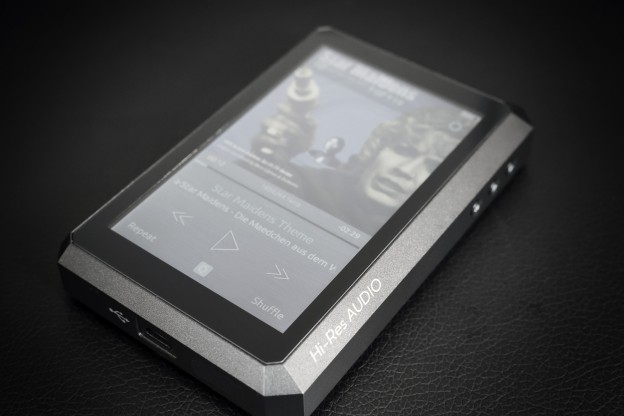Audio-OPUS #1 High Resolution Portable Audio Player – Review
Intro
Korean tech company ‘thebit’ (The Best Internet Technology) has started high in its naming of the OPUS#1 player, making us think of sublime classical compositions and other arty treats; but does the OPUS#1 hit the right notes?
Design and appearance
The OPUS#1 has a slightly angular and bevelled look which is reminiscent of Astell&Kern’s recent efforts, but with a slightly softened feel in comparison. It’s a pattern which is reflected in the sound of the player when compared to A&K but more on that later. The touchscreen is very responsive and easy to operate, with a good choice of navigation methods available with the player software. We can navigate by song, album, artist, genre, favorites and also by folder, which should keep everyone happy.
With a firmware update (1.10.15 at this time) the player remembers the track which was last listened to, if the track was paused and the player allowed to enter ‘hibernation mode’. Upon reawakening the player, the music resumes from where it was paused.
The OPUS 1 case is made using enhanced ABS and tempered glass, similar to many of the newer Smartphone’s on the market, the tempered glass covers almost all of the front and back of the player, giving the player OPUS#1 a premium feel, while the ABS shell reduces the overall weight of the player.
Key Features
Slots for two MicroSD cards (currently up to a capacity of 200Gb each) together with the on-board storage of 32Gb make the Opus#1 a heavyweight in terms of capacity, and the clear screen and intuitive navigation make it a breeze to find what we wish to listen to.
The sound can be moulded to the tastes of the user by way of the EQ feature in the player; there are three user EQ settings which can be stored, there is a delay of 3 or 4 seconds between selecting EQ settings and hearing any changes come through in the sound, why I am not sure, but in a strange way it gives you a chance to here how the EQ has changed the sound, but it is an unusual delay that may frustrate you for a few seconds.
The Opus#1 can handle all popular formats up to 24bit/192KHz and also DSD so we can take advantage of all that storage capacity with high quality files! Also the optical output can feed audio data to an external DAC for use with a full-size hi-fi system or a dedicated headphone amp, although the Opus#1 does sound pretty spectacular already.
Durability & build quality
The case as mentioned made of high quality tough ABS and the player certainly feels substantial and solid, but without feeling too heavy or bulky. That is partly due to the front and back being tempered glass (the front being the touchscreen, obviously!).
Buttons are present on the sides and are easy to operate with a good feel; they also function when the screen is inactive but shouldn’t cause any trouble with the player being used whilst in a pocket or bag. Use of the leather case reduces any chance of unwanted button presses, but it is rather tight,and once on, hard to get off again!
Sound Quality
Some players have an ultra-accurate sound with which there is a danger of getting too cold and clinical, and others give an overly warm sound which can be further accentuated by choice of headphones. The Opus#1 does very well at occupying the middle ground, giving a very clear presentation which is also very musical. Most headphones an earphones will likely respond well to this, making the Opus#1 a good choice for those who already own decent quality headphones and seek to get the best from them.
Pros:
Good solid build,
Sound quality clear and well balanced,
Good amount of power for portable headphones,
Full navigation options,
Leather case is a nice extra but hard to remove
Cons:
EQ effect is delayed
Summary
For a first attempt, the Opus#1 is an amazing effort and promises to be very competitive amongst offerings of much more established companies like Astell and Kern. There’s more to come from makers ‘thebit’ and we are looking forward to future products too!
OPUS#1 specifications.
24bit / 192kHz High Resolution Sound
32bit processor core
Cirrus Logic CS4398 x 2EA Dual DAC
ARM Cortex-A9 1.4GHz, Quad-Core CPU DDR3 1GB
SNR 115dB, THD+N 0.0007%, Crosstalk – 130dB, Output 2Vmrs
Low-clock-jitter sensitivity: 50ps(Typ)
4inch TFT Wide Touch Display (480 x 800)
WAV, FLAC, ALAC, AIFF, DSD, WMA,
MP3, OGG, APE(Normal, High, Fast)
Internal Memory 32GB
External Micro SD Card Memory 200GB x 2EA
Enhanced ABS Solid Body and Tempered Glass
Audio Performance
DAC
CS4398 * 2EA(Dual DAC)
Decoding
Support up to 24bit / 192KHz Bit to Bit Decoding
Frequency Response
±0.02dB(Condition: 20Hz~20KHz) Unbalanced & Balanced
±0.3dB(Condition: 10Hz~70KHz) Unbalanced & Balanced
Signal to Noise Ratio
114dB @ 1KHz, Unbalanced
115dB @ 1KHz, Balanced
Crosstalk
130dB @ 1KHz,Unbalanced / 135dB @ 1KHz, Balanced
THD+N
0.0007% @ 1KHz
Output Impedance
Balanced out 2.5mm(1ohm) / PHONES 3.5mm(2ohm)
Ouput Level
Unbalanced 2.1Vrms / Balanced 2.3Vrms(Condition No Load)

Very helpful review of the Opus 1.
I am using a 160GB iPod (which of course sadly are not made any more) and Shure SE535 earphones.
This Apple iPod player naturally integrates perfectly with iTunes when connected via UBS to my computer.
Can digital players like the Opus 1 similarly integrate with iTunes to upload and update music tracks automatically?
Thanks,
Robert.